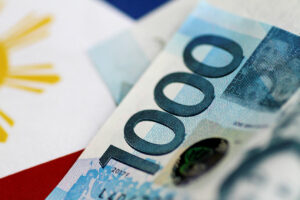NG debt hits P13.75T as of end-Feb.

By Keisha B. Ta-asan, Reporter
THE NATIONAL Government’s (NG) outstanding debt hit a record-high P13.75 trillion as of end-February as domestic borrowings increased, the Bureau of the Treasury (BTr) said on Thursday.
Preliminary data from the BTr showed outstanding debt inched up by 0.4% or P54.26 billion from the P13.698 trillion as of end-January “primarily due to the net issuance of domestic securities.”
Overall debt grew by 13.7% from P12.09 trillion as of end-February 2022. Year to date, debt rose by 2.5% from the P13.42 trillion as of end-December 2022.
Of the total, 68.7% of the debt portfolio was from domestic lenders while the rest were from external sources.
Domestic debt stock jumped by 12.2% to P9.442 trillion from P8.413 trillion a year ago. Month on month, it inched up by 0.6% from the P9.384 trillion as of end-January.
The BTr attributed the higher domestic debt mainly to “net availment of domestic financing amounting to P55.88 billion and the P1.34-billion effect of local currency depreciation against the US dollar on onshore foreign denominated securities.”
Based on figures from the BTr, the peso depreciated by 1.2% to P55.21 against the dollar from the P54.57 at end-January.
The government mainly borrows from domestic sources to mitigate foreign currency risk.
Meanwhile, external debt increased by 17.1% to P4.31 trillion at end-February from P3.68 trillion a year ago. Month on month, it dipped by 0.1% from P4.313 trillion.
Broken down, external debt consisted of P1.883 trillion in loans and P2.427 trillion in global bonds.
The month on month increase in foreign debt was “due to the P21.15-billion net repayment of foreign loans and P32.32-billion impact of third-currency adjustments against the US dollar,” the BTr said.
“These outweighed the effect of local currency depreciation against the US dollar, which amounted to P50.51 billion,” it added.
As of end-February, the NG’s overall guaranteed obligations slipped by 1.7% to P387.19 billion from P393.84 billion in the previous month. Year on year, it declined by 7% from P416.2 billion.
Rizal Commercial Banking Corp. Chief Economist Michael L. Ricafort said the increase in debt was due to the government’s retail Treasury bond (RTB) issuance in February, which raised P283.711 billion.
However, net repayment of some government debt due to the rise of government securities effectively reduced the outstanding debt, Mr. Ricafort added.
ING Bank N.V. Manila Senior Economist Nicholas Antonio T. Mapa said the overall debt may continue to increase in the next few years as the government is expected to incur budget deficits.
“Despite projected improvements in revenue collection, the government will likely need to resort to borrowing to shoulder expenditure to sustain economic growth,” Mr. Mapa said in an e-mail.
However, the government should keep an eye on the overall debt-to-gross domestic product (GDP) ratio.
“Should growth outstrip the growth of new debt, we could see a decline in the debt-to-GDP ratio which would indicate that the economy is able to outgrow the high debt issue,” Mr. Mapa said.
As of end-December, the country’s debt-to-GDP ratio stood at 60.9%, improving from the 63.7% ratio as of end-September.
This debt-to-GDP ratio is lower than the 61.8% target under the medium-term fiscal framework, but still above the 60% threshold considered manageable by multilateral lenders for developing economies.
The government aims to cut the debt-to-GDP ratio to less than 60% by 2025, and further to 51.5% by 2028.
The government plans to borrow P2.207 trillion this year, where 75% is expected to be sourced domestically.
Finance Secretary Benjamin E. Diokno earlier said there are plans to launch a benchmark-sized retail dollar bond offering in April.




